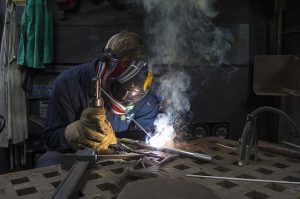
Welding is an essential fabrication process used in the manufacturing and commercial construction industries to join multiple objects. As you may know, it involves heating the respective objects, thereby causing them to melt. As the objects begin to cool, they fuse together to create a secure connection. While all welding processes are performed by melting the objects, there are two primary ways in which they are performed: forehand or backhand. So, what’s the difference between forehand and backhand welding?
What Is Forehand Welding?
Forehand welding is a welding technique that’s characterized by the application of the rod before the torch. With forehand welding, the worker holds the torch at roughly a 30-degree angle from his or her right side. This allows the torch to point directly between the rod and welding puddle.
When compared to backhand welding, forehand welding offers a superior level of penetration. The torch is able to heat hard, dense objects by penetrating through them. The downside to forehand welding is that it tends to produce more splatter while also promoting an inconsistent arc.
What Is Backhand Welding?
Backhand welding is a welding technique in which the worker welds the objects from left to right. Also known as pull welding, it involves applying the torch before the rod itself. Although there are exceptions, backhand welding is typically included to about a 15-degree angle on the worker’s right side. The worker is then able to add the filler metal from his left side.
Backhand welding offers several benefits, one of which is a consistent arc. Because of the position of the torch and filler rod, the worker is able to create an even and consistent arc. In turn, this allows the worker to evenly distribute the filler metal. Backhand welding also creates less splatter than forehand welding, making it desirable among workers.
Forehand and Backhand Welding for Other Fabrication Processes
With names such as “forehand welding” and “backhand welding,” you may assume that are only used for welding. However, both of these techniques can be used for other fabrication processes, including brazing and soldering. Brazing and soldering, of course, are unique fabrication processes because, unlike with welding, they don’t melt the objects intended to be joined. Regardless, forehand and backhand techniques can be used for all three fabrication processes.
The main difference between forehand and backhand welding is the way in which the torch and rod are held. Forehand welding involves holding and applying the torch before the rod, whereas backhand welding involves holding and applying the rod before the torch.
